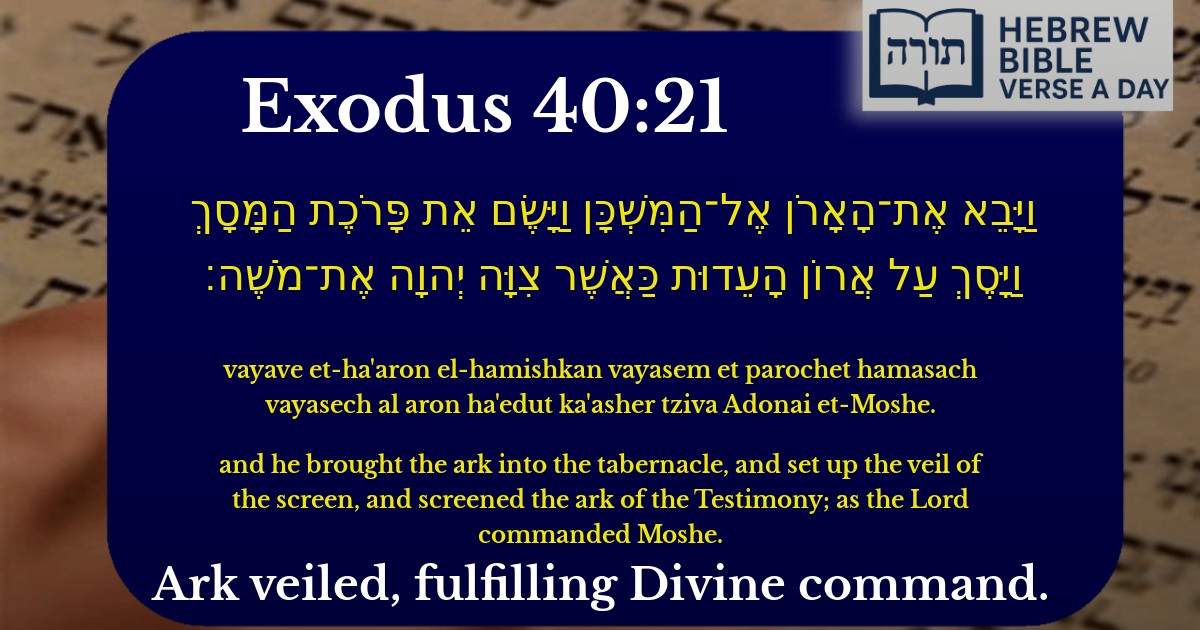Join Our Newsletter To Be Informed When New Videos Are Posted
Join the thousands of fellow Studends who rely on our videos to learn how to read the bible in Hebrew for free!
Hebrew Text
וַיָּבֵא אֶת־הָאָרֹן אֶל־הַמִּשְׁכָּן וַיָּשֶׂם אֵת פָּרֹכֶת הַמָּסָךְ וַיָּסֶךְ עַל אֲרוֹן הָעֵדוּת כַּאֲשֶׁר צִוָּה יְהוָה אֶת־מֹשֶׁה׃
English Translation
and he brought the ark into the tabernacle, and set up the veil of the screen, and screened the ark of the Testimony; as the Lord commanded Moshe.
Transliteration
Vayave et-ha'aron el-hamishkan vayasem et parochet hamasach vayasech al aron ha'edut ka'asher tziva Adonai et-Moshe.
Hebrew Leining Text
וַיָּבֵ֣א אֶת־הָאָרֹן֮ אֶל־הַמִּשְׁכָּן֒ וַיָּ֗שֶׂם אֵ֚ת פָּרֹ֣כֶת הַמָּסָ֔ךְ וַיָּ֕סֶךְ עַ֖ל אֲר֣וֹן הָעֵד֑וּת כַּאֲשֶׁ֛ר צִוָּ֥ה יְהֹוָ֖ה אֶת־מֹשֶֽׁה׃ <span class="mam-spi-samekh">{ס}</span>
וַיָּבֵ֣א אֶת־הָאָרֹן֮ אֶל־הַמִּשְׁכָּן֒ וַיָּ֗שֶׂם אֵ֚ת פָּרֹ֣כֶת הַמָּסָ֔ךְ וַיָּ֕סֶךְ עַ֖ל אֲר֣וֹן הָעֵד֑וּת כַּאֲשֶׁ֛ר צִוָּ֥ה יְהֹוָ֖ה אֶת־מֹשֶֽׁה׃ {ס}
🎵 Listen to leining
Parasha Commentary
📚 Talmud Citations
This verse is quoted in the Talmud.
📖 Yoma 54a
The verse is referenced in the discussion about the placement of the Ark in the Tabernacle and the subsequent practices in the Temple.
📖 Sotah 35a
The verse is cited in the context of discussing the commandments given to Moses regarding the Ark and the Tabernacle.


Context of the Verse
This verse (Shemot 40:21) describes Moshe's actions in completing the Mishkan (Tabernacle) according to Hashem's command. The placement of the Aron HaEdut (Ark of the Testimony) behind the Parochet (veil) signifies the sanctity and separation of the innermost chamber, the Kodesh HaKodashim (Holy of Holies).
Rashi's Commentary
Rashi explains that the phrase "וַיָּשֶׂם אֵת פָּרֹכֶת הַמָּסָךְ" ("and set up the veil of the screen") refers to Moshe hanging the Parochet to separate between the Kodesh (Holy) and the Kodesh HaKodashim. He emphasizes that this was done precisely "כַּאֲשֶׁר צִוָּה יְהוָה אֶת־מֹשֶׁה" ("as Hashem commanded Moshe"), highlighting Moshe's exact adherence to divine instruction.
Rambam's Perspective
In Hilchot Beit HaBechirah (Laws of the Temple), Rambam discusses the significance of the Parochet as a barrier that maintains the sanctity of the Aron. Only the Kohen Gadol (High Priest) could pass beyond it, and only on Yom Kippur, underscoring the Aron's supreme holiness.
Midrashic Insights
Halachic Implications
The Talmud (Yoma 51b-52a) derives from this verse that the Parochet must be hung before placing the Aron inside the Kodesh HaKodashim, teaching a principle about the order of sanctifying sacred spaces. This halachah emphasizes the importance of proper preparation before introducing objects of kedushah (holiness).
Symbolism of the Aron and Parochet
The Aron, containing the Luchot (Tablets), represents the divine covenant, while the Parochet acts as a reminder of the boundaries between human and divine realms. The Vilna Gaon notes that this mirrors the relationship between Torah study (revealed wisdom) and Kabbalah (hidden wisdom), both protected and accessed with reverence.